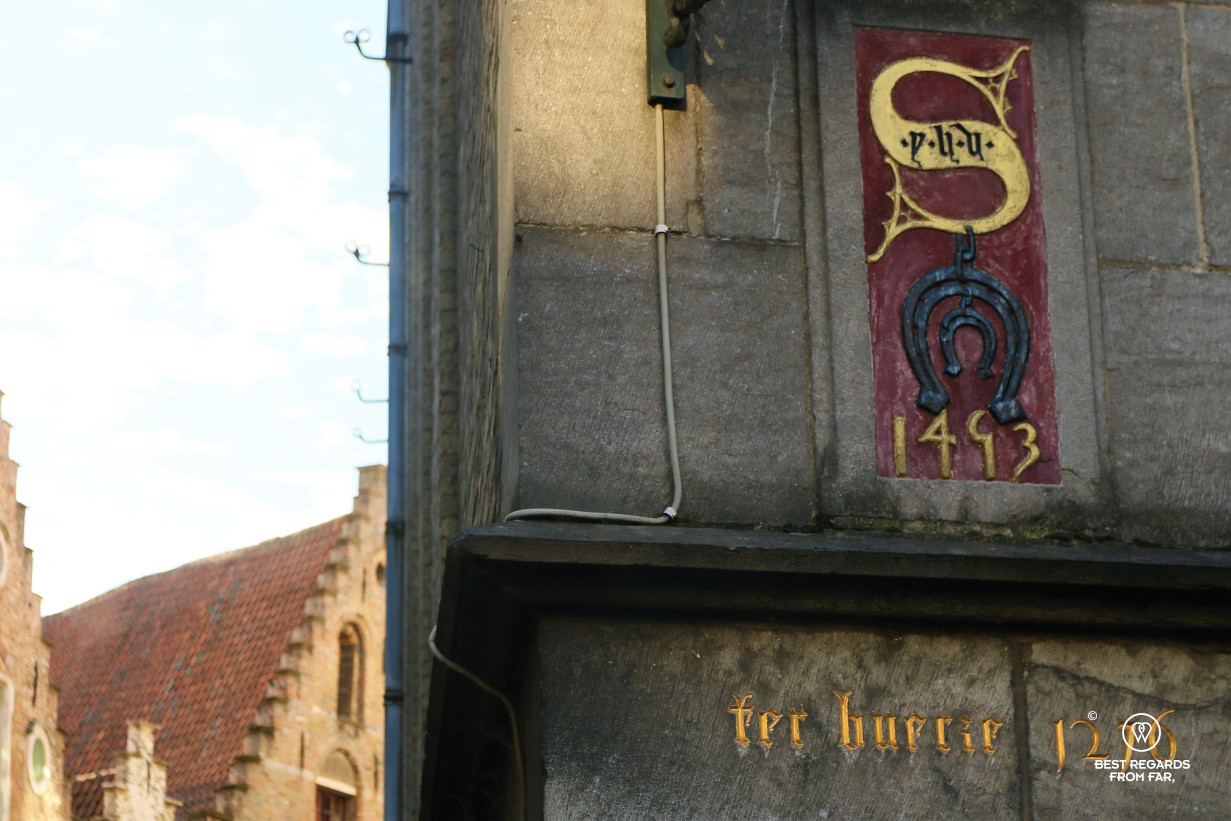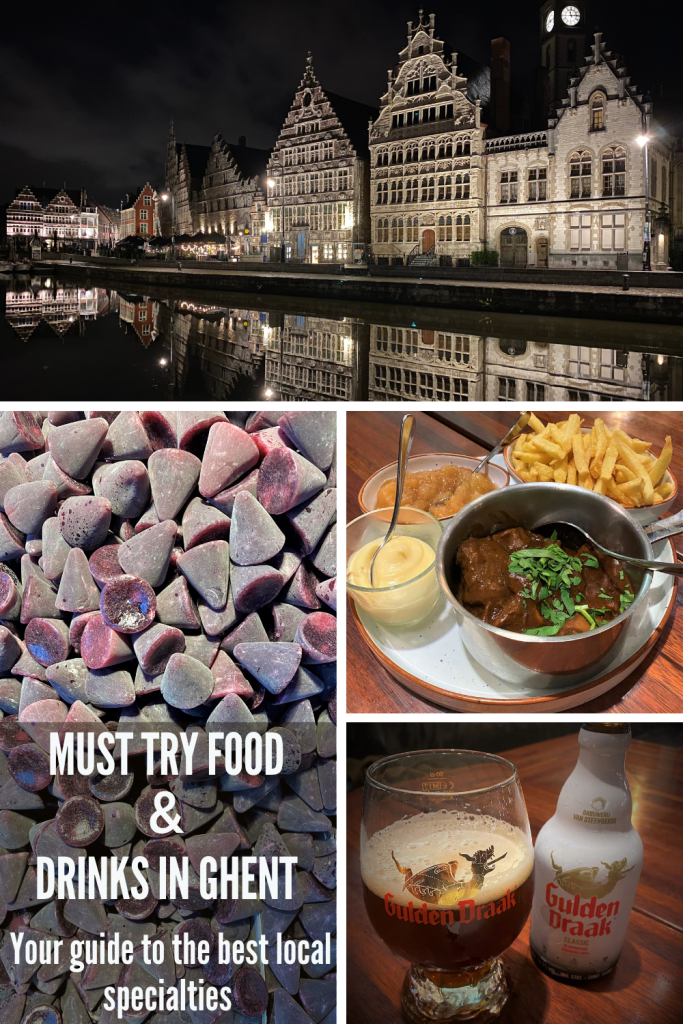Text: Claire Lessiau & Marcella van Alphen
Photographs: Claire Lessiau & Marcella van Alphen
Bookmark it or pin it for later!
1. Bruges: a perfectly preserved medieval city, right? Well… no!
Standing on the romantic Bonifacius Bridge, taking a selfie or kissing your lover on Bruges’ most romantic bridge, and mesmerizing over all the old medieval structures next to the Church of Our Lady and the Gruuthuse Palace… Bruges is the post-card perfect medieval city! Except that despite the appearances, you are standing on one of Bruges’ most recently built bridges dating back to… 1910! In fact, most of medieval Bruges consisted of wooden houses which are long gone apart from the late 15th century timber house at Genthof 7 and the 16th century wooden structure on Vlamingstraat 9. Ever since the 17th century, these timber houses were forbidden as city fires were unforgiving. Most of houses in Bruges’ you can see today actually date back to the 16th and 17th century and to the 19th and 20th century when many were restored in a Neogothic style that gives Bruges its authentic medieval vibes. Actually, the poverty of Bruges after its decline at the end of the 15th century has preserved the city as inhabitants were fixing existing buildings rather than building new ones. The city did not have the money to modernize and construct large boulevards like in Paris. It has always kept its medieval city plan with its intricate streets that may be even more lovely to stroll at night.


2. The most haunted house of Bruges…
The house at the Spanjaardstraat 17 at the corner by the Augustine Bridge is known by locals as the most haunted house of the city. Even today, new inhabitants never last for too long and tend to move out within a year. It used to be a convent for the nuns while on the opposite of the canal there used to be an Augustinian Monastery. The monks frequented the convent to hear confessions and to administer communion. One day in 1498, an Italian monk fell in love with a young nun who loved him back. They both prayed for their feelings to disappear, in vain. One night, the monk discovered a secret tunnel linking both buildings, and he could not resist visiting the beautiful nun. He prayed and begged her to run away with him. No one had seen them ever since…

This is when strange things started to happen in the convent and not much later the nuns abandoned it: a female figure dressed in white floating through rooms and vanishing through walls, a male figure dressed in black with a grim expression on his face appeared occasionally. In 1890, an English couple moved in and was startled by the phenomena. They invited the well-known spiritualist William Eglinton, and the famous novelist Florence Marryat to document his séances. The spirit of the monk revealed he had been stalking the young nun, but she turned her back at him respecting her religious vows. Enraged, he stabbed her to death in the tunnel, and took his own life. Marryat herself said to have communicated with the nun and figured that she was the 23-year old Hortense Dupont. She spoke: “I did love him. I couldn’t help it.” And she asked to pray for the monk… whether you believe in it or not, the facts are that one day, the secret passage-way was rediscovered, and two skeletons, a male and female, recovered along with a dagger…
3. The only beer pipeline in the world!
When De Halve Maan brewery decided to expand in 2016 to cope with the success of their newest beer, the Brugse Zot, that is exported to more than 30 countries, they could have simply moved their brewing facility outside of Bruges. But there is something unique about brewing beers where a brewery has been continuously doing so since 1564! And there is something very special about visiting such a facility in the heart of the city, and enjoying a beer there. This is why a 3.276-kilometre (2 mi) beer pipeline was designed and installed to link the brewery to the maturation and bottling facility just outside of town. With the construction of the parking lot of the Concertgebouw, the pipeline had to be as deep as 37 metres underground at times. The other constraint was to not go under any private land, as the landowners could have tapped into the pipeline! For the first few hundred meters, the pipeline follows an intricate path with a few corners to ensure it always stays below public lands. The pipeline includes five pipes: two for beer that has to travel at low velocity because of the yeast (it takes 45 minutes for the beer to reach the bottling plant), two for water (one to bring water to the brewery for the brewing process, one to clean the beer pipes), and one to detect leaks, all in a high density polyethylene tube.




This is one of the initiatives that allows Bruges to be more than an open-air museum, by having local businesses operating within the city, without affecting it too much with heavy truck traffic. It is all the more important as authentic businesses like De Halve Maan tend to make way for souvenir shops of “not so made in Bruges” goods…
4. Most of the chocolates sold in Bruges are not even made in Belgium.
In the Middle Ages “Made in Bruges” meant luxury. Today, with 20,000 inhabitants within the old city and 6.7 million tourists yearly, chocolates “made in Bruges” for every one of them seems doubtful… And it often is! Indeed, some dubious chocolate stores sell chocolate not even made in Belgium as being from Bruges. To counter this issue, the municipality has designed a logo for visitors to spot stores where the chocolate is indeed “made in Bruges”: look for the cacao pod framed by two swans.



If you are a chocolate addict, the Choco-Story Museum is very informative and retraces the history of chocolate from pre-historical times until today, as well as its agricultural and industrial processes, concluding with a demonstration of chocolate-making (and tasting!). For the best chocolates in town, head to The Chocolate Line, the award-winning artisanal shop of the innovative and socially and environmentally-conscious Dominique Persoone.
5. The inhabitants of Bruges are called the “fools of Bruges”.
After the death of Mary of Burgundy in 1482, who had been ruling Flanders, her widower Maximilian took over. Having lost his beloved wife in Bruges, he had strong resentment against the city, and taxed it heavily to finance his wars. The second most powerful person after the pope, he was not popular in Flanders, and people became hostile to him. In 1488, he visited Bruges, and the people rebelled: Maximilian was jailed in the Craenenburg House on the Markt for over four months. To pressurize him even more, his trusted sheriff, Pieter Lanchals, was tortured and beheaded under his window. Maximilian reconsidered the tax, and when he was freed, the people of Bruges organized a celebration to honour him and more importantly to calm him down. They seized the opportunity to request a new mental hospital for the city. Maximilian objected that they already had it: there were so many fools in town that they just had to close the city gates! Since that day the nickname of the people of Bruges is ‘the fools of Bruges’ and the literal translation of today’s best-selling beer brewed in Bruges: the “Brugse Zot”.


6. The swans on the canals are not here for your romantic selfies!
As explained above, Pieter Lanchals was tortured and beheaded on the Market Square as the people of Bruges took all the hatred they had for Maximilian on him. His head was displayed on a spur at the Gentpoort, where today you can still find a replica. Maximilian did not want this affront to stay unpunished: his soldiers plundered the city and destroyed its fortified walls. The legend has it that to commemorate Maximilian’s revenge, no less than 100 lanchalzen or swans (literally: long necks, referring to Pieter Lanchals nicknamed the Long Neck and whose coat of arm consisted of a swan) are to be taken care of by the people of Bruges until eternity. In the Middle Ages, swans were eaten and caring for them without consuming them was a high cost to a city and a sign of wealth. Today, about 250 swans roam the canals of Bruges. If their number was to drop below 100, the legend says that Bruges would decline to never recover, and the municipality is seriously taking care of them and regulating their population.



7. Have you ever wondered where the stock exchange got its name from?
The main basic concepts of modern banking and stock markets were first developed in Italy, and introduced into the rest of Europe via Bruges. In the 13th century, Bruges was wealthy mostly thanks to the foreign traders doing business in town. The people of Bruges themselves, more specifically the innkeepers, were often involved only as intermediaries. They were not only offering accommodation and meals, but also storage space for the goods exchanged and more importantly, they would put foreign traders in touch with each other and facilitate transactions. The van der Beurzes were the most important family of innkeepers of Bruges. The Ter Beurze building that was in business already in 1276 still stands close to the Markt. This inn was well-known for its excellent location close to the trading heart of town, and by the nation houses of the powerful Italian city-states of Venice, Lucca, Genoa and Florence as well as English, Portuguese and Spanish. The legend has it that one day, two foreign merchants were meeting in the Ter Beurze inn. One had a cargo of cacao beans, the other, diamonds. They wanted to trade together, but as the price was based on weight, they decided to write the exchange on a simple piece of paper, creating the first bill of exchange. In around 1415, traders used to meet at Ter Beurze, either on the square in front of it or in the inn when it rained, to exchange commodities, bonds, bills of exchange, and even insurance. Still today, this word has been used in many languages to refer to the stock exchange (“beurs” in Dutch, “bourse” in French, “borsa” in Italian, “bolsa” in Spanish, “Börse” in German…).

8. Public bathhouses: the one-stop shop from business deals to carnal pleasures…
Before closing the deal at Ter Beurze, negotiations often happened in the inns of course, but also at public bathhouses. During the Middle Ages, only the wealthiest had private bathrooms. Most would just wash from a jug. With many foreign traders, sailors and travellers, public bathhouses were an important institution. Meeting hub, relaxing place and brothel, this is where men would meet, learn about the state of affairs in other countries, listen to music, share a good meal, wash, and enjoy intimate contacts. If brothels were illegal in Bruges, the municipality would simply ignore the bathhouses that had an important function. The Stoofstraat was the hot spot, and still today its signs showcase what these bathhouses looked like.


Travel tips:
- To plan your trip, check out our article about 72 hours in Bruges and refer to Visit Bruges.
- Check out this interactive map for the specific details to help you plan your trip and more articles and photos (zoom out) about the area! Here is a short tutorial to download it.
For more around Bruges & Ghent, click on theses images:







Love Bruges